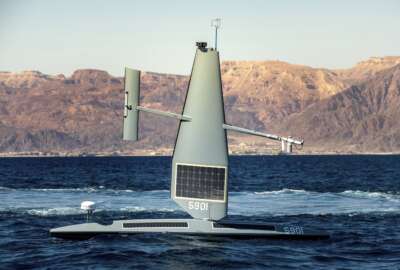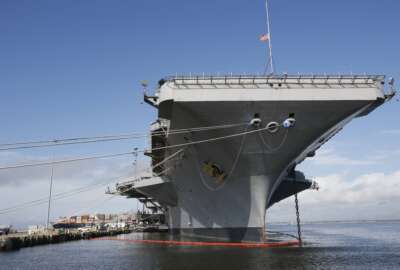Navy charts massive transformation in shipboard IT as commercial 5G, satellite links join the fleet
The Navy sees a not-too-distant future in which sailors aboard ships have the same level of connectivity they have on shore, thanks almost entirely to advances ...
When it comes to what the Navy can and can’t do while its ships are at sea, one of the biggest considerations is network bandwidth: Right now, everything from operational planning to administrative processes are premised on the fact that vessels are constrained by very narrow data pipes while they’re underway.
But technologists at the Naval Information Warfare Systems Command (NAVWAR) foresee a not-too-distant future in which bandwidth is almost a non-issue, and the IT experience on a ship doesn’t look too different from what sailors get on shore-based networks.
The biggest potential game-changers, officials say, are technologies like 5G and proliferated low-Earth orbit satellite constellations that have already been widely deployed commercially. If the Navy can successfully adopt them at scale, it would be the biggest leap ahead in network connectivity since the service first installed its earliest wideband satellite terminals on its ships in 1991.
“What we’re looking at with 5G and P-LEO is the same level of transformation, but much more profound and a much greater exponential curve,” Rob Wolborsky, NAVWAR’s chief engineer said during an interview for Federal News Network’s On DoD. “The capability that is in orbit today is multiple orders of magnitude more bandwidth that we can deliver to the fleet and the warfighter today, and it is a catalyst for a significant amount of activity and transformation.”
In “blue water” environments far from shore, most of the potential for better connectivity to DoD’s networks and the public Internet lies in P-LEO constellations. Although Starlink is the best-known, other commercial providers are developing their own large fleets with global coverage, and the Space Development Agency is contracting for a DoD-specific “transport layer” for global communications. The difference in throughput is huge: Right now, military SATCOM capabilities provide perhaps one or two megabits of bandwidth to each ship — a tiny fraction of what most residential Internet customers get at home. P-LEO networks can deliver hundreds of megabits at a time to each ship.
When it comes to 5G, the Navy sees huge potential in using the technology to establish low-latency high-bandwidth communications between ships in relatively close proximity to one another, and also to improve local networking within a particular ship without having to conduct a costly and time consuming overhaul of its wired network infrastructure.
“Today, latency can be an issue with regards to communication from one vessel to another and from ship to shore … 5G has the ability to deliver data faster to and from, let’s say, two planes — you can deliver data faster, and essentially the ultimate benefit is that intel can be collected and delivered faster,” said Ron Wolfe, NAVWAR’s technical warrant holder for mobility. “The biggest benefit for the research we’re doing is to mitigate latency, and future capabilities will be added because of that. So there’s technology we’ve wanted to add to our systems for several decades that we couldn’t really do because latency became an issue. 5G lets us mitigate that.”
But 5G also has a place in connecting ships to the outside world, Wolborsky said.
“When a ship is in port or going into port, 5G is multiple orders of magnitude more throughput than what they get today — typically through physical pierside umbilical connections,” he said. “The physical connections are fragile and break and cost a lot of money, and you have to have a team of people to be able to connect these things. If you can come into port and seamlessly connect to the shore infrastructure with significantly more bandwidth and throughput, it’s another benefit to the platforms. We’re doing quite a bit of experimentation and work right now on the ships with 5G as a pier surrogate, and it’s actually demonstrating significant benefit to the fleet.”
The high-bandwidth P-LEO connections aren’t far off either. Wolborsky said Starlink has already been deployed on some vessels, and NAVWAR has developed an open architecture framework to let the Navy more easily adopt offerings from other commercial satellite providers as those come online.
“We’re moving as fast as we physically can to make this happen for the fleet, and it’s ahead of things like the traditional DoD requirements and acquisition process — we’re not necessarily operating within the confines of that,” he said. “But we’re also moving faster and more aggressively coordinating with the fleet and sharing the cost in advance of all of this becoming some big program of record. I’m providing the engineering discipline and rigor to make sure that it’s being delivered properly, it’s being properly secured, that we’re assessing electromagnetic interference and all the things that you need to do to get this on the ships as fast as we can.”
One reason the Navy thinks it can move faster with 5G and P-LEO than with traditional shipboard programs of record is that the hardware involved is physically much smaller, and already proven in the commercial market.
Wolborsky stressed the Navy doesn’t intend for commercial communications technologies to fully replace existing military SATCOM links — the intention is to give commanders as many options as possible. But as a practical matter, the commercial options are a whole lot easier to install and upgrade than what the Navy has become accustomed to.
These P-LEO systems come with apertures that are not much bigger than a pizza box. You can put them almost anywhere on the ship in a weekend or less, and our original Starlink antennas were actually attached using magnets, he said. “That’s compared to a two-ton, eight-foot antenna that takes an extraordinary amount of money and time and energy to install on the ship … in the older paradigm we’d have to find an availability when the ship was tied up for six months to a year, and then we’d have to go do a whole bunch of very costly and time consuming work.”
And once every ship in the fleet has several hundred megabytes of bandwidth available at all times, officials believe the rest of the assumptions the Navy has always made about IT system design will change dramatically.
“We in the Navy have lived in a [limited bandwidth] mindset in the digital world for the past 30 years. We’ve always thought, ‘Well, we can’t build an application that uses too much bandwidth.’ We’re opening the aperture now,” he said. “We’re letting all the community owners and building architectural analyses to let them know what they can do, how they can open the aperture. Ready Relevant Learning can be distributed to a ship on deployment in the middle of the Atlantic Ocean. We can actually use this capability to allow the specialist at Bethesda to help a ship’s doctor perform surgeries and other things that they could never have done without having somebody there to help them think about it. What we can do is almost infinite, and we’re communicating as aggressively as we can across the entire Navy that people should start to think about the afloat domain in the same terms as what they can do at terrestrial sites.”
Copyright © 2024 Federal News Network. All rights reserved. This website is not intended for users located within the European Economic Area.
Jared Serbu is deputy editor of Federal News Network and reports on the Defense Department’s contracting, legislative, workforce and IT issues.
Follow @jserbuWFED






